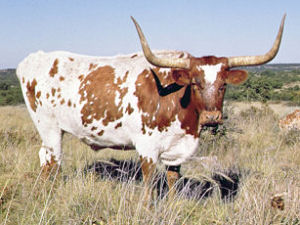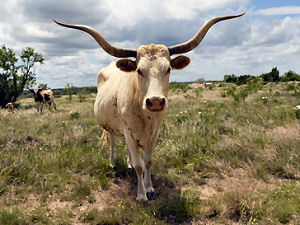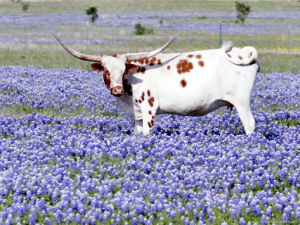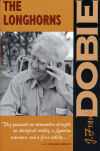
HOME
INTRO
SYMBOLS
ALMANAC
ECONOMY
GEOGRAPHY
STATE MAPS
PEOPLE
FORUM
NEWS
COOL SCHOOLS
STATE QUIZ
STATE LINKS
BOOK STORE
MARKETPLACE
NETSTATE.STORE
NETSTATE.MALL
GUESTBOOK
CONTACT US


Dbl click any word in
document for definition.
Texas Large State Mammal

Texas Large State Mammal: Longhorn
Photographs, prints, and posters
After tabulating the votes of a number of elementary school children, support for the longhorn and the armadillo was evenly divided. So, House Concurrent Resolution No. 178 proclaimed that there should be an official large state mammal AND an official small state mammal.
Of course, the most distinguishing feature of a longhorn is its long horns, which can measure up to seven feet from tip to tip. Horns come in different styles too. Horns can rise upward close to the head or at the tip of the horn. They can have a slight upward turn at their tips or even a triple twist. Texas longhorns are also known for their wide variation in color.
Longhorns also come in "miniature." Miniature longhorns are bred to be approximately 1/3 the size of a standard longhorn.
H.C.R. No. 178
HOUSE CONCURRENT RESOLUTION
WHEREAS, The State of Texas traditionally has recognized a variety of official state symbols as tangible representations of the proud spirit and heritage of our state; and
WHEREAS, The bluebonnet, the pecan tree, the Guadalupe bass, and the lightning whelk are examples of some natural specimens that serve to symbolize the great diversity of the Texas landscape, while the state dish, chili, fittingly represents another aspect of our shared culture as Texans; and
WHEREAS, In keeping with this custom, the designation of an Official State Mammal of Texas has been the subject of an extensive statewide mock election participated in by hundreds of elementary schoolchildren throughout our state; and
WHEREAS, The two front runners in this race have been the armadillo and the longhorn; and
WHEREAS, Once the cornerstone of the Texas cattle industry, an estimated 10 million longhorns were herded from Texas to midwestern and western markets during the quarter century that followed the Civil War, providing invaluable stability to the state's postwar economy; and
WHEREAS, The longhorn's distinctive profile commands an immediate association with the State of Texas nationwide and is fittingly used as a visual symbol by businesses from the Rio Grande Valley to the Panhandle; and
WHEREAS, The other candidate for designation as Official State Mammal, the armadillo, is a hardy, pioneering creature that chose to begin migrating here at about the time that Texas became a state; and
WHEREAS, The armadillo possesses many remarkable and unique traits, some of which parallel the attributes that distinguish a true Texan, such as a deep respect and need for the land, the ability to change and adapt, and a fierce undying love for freedom; and
WHEREAS, As proud and indomitable as the state from which they hail, both the longhorn and the armadillo will serve as fitting symbols of Texas' unique heritage; now, therefore, be it
RESOLVED, That the 74th Legislature of the State of Texas hereby designate the longhorn the official Large State Mammal of Texas and the armadillo the official Small State Mammal of Texas.
The longhorn became the official large state mammal of Texas when Governor George W. Bush signed House Concurrent Resolution No. 178 on June 16, 1995. The same resolution named the armadillo the official small state mammal of the State of Texas.
Also in 1995, a third mammal was named to represent Texas when Senate Concurrent Resolution No. 95 was signed. The Mexican free-tailed bat was named the official flying mammal of the State of Texas.
TRIVIA: 25 years before there was an official state large mammal, there was an official state longhorn herd.
Texas Law

Texas Large State Mammal: Longhorn
Photographs, prints, and posters
The longhorn was named the official large state mammal of the State of Texas by House Concurrent Resolution and is not, therefore, listed in the Texas Statutes.
Only a few of Texas' myriad symbols were actually adopted by an act of the legislature and written into the Texas Statutes.
Sources...
The State of Texas. Legislative Reference Library. House Concurrent Resolution No. 178. Austin: The State of Texas, 1995. Web. .
The State of Texas. Texas Legislature Online. Texas Statutes. Austin: The State of Texas, 2012. Web. .
Texas Longhorn Breeders Association. Texas Longhorn Breeders Association, n.d. Web. 28 Feb 2012. .
Shearer, Benjamin F. and Barbara S. State Names, Seals, Flags and Symbols: A Historical Guide Third Edition, Revised and Expanded. Westport, Conn: Greenwood Press, 3 Sub edition, 2001.
Additional Information

Texas Large State Mammal: Longhorn
Photographs, prints, and posters
Texas Longhorn: Oklahoma State University: Department of Animal Science. Survivor of the Past - Bright Promise for the Future by Dr. Stewart H. Fowler, PhD.
LONGHORN CATTLE: Texas State Historical Association: The Handbook of Texas Online.
Bos taurus (aurochs, domesticated cattle): The University of Michigan Museum of Zoology: Animal Diversity Web.
Bos taurus - Linnaeus, 1758, Aurochs: A network connecting science with conservation - NatureServe Explorer: An Online Encyclopedia of Life.
Bos taurus (Linnaeus, 1758): Integrated Taxonomic Information System (ITIS) Here you will find authoritative taxonomic information on plants, animals, fungi, and microbes of North America and the world.
Texas Longhorn Breeders Association: Official website.
Texas Longhorns in State Parks: Texas Parks and Wildlife Department.
The Texas Longhorns: U.S. Fish and Wildlife Service: Wichita Mountains Wildlife Refuge.
State mammals: Complete list of official state mammals from NETSTATE.COM
More symbols & emblems: Complete list of official Texas state symbols from NETSTATE.COM.

The Longhorns
J. Frank Dobie
The Longhorns, J. Frank Dobie. 440 pages. Publisher: University of Texas Press (1980) The Texas Longhorn made more history than any other breed of cattle the world has known. These wiry, intractable beasts were themselves pioneers in a harsh land, moving elementally with drouth, grass, Arctic blizzards, and burning winds. Their story is the bedrock on which the history of the cow country of America is founded.
In The Longhorns, he tells of the Spanish conquistadors, who brought their cattle with them; of ranching in the turbulent colonial times; of the cowboy, whose abandon, energy, insolence, and pride epitomized the booming West. He writes of terrifying stampedes, titantic bull fights on the range, ghost steers, and encounters with Indians.

